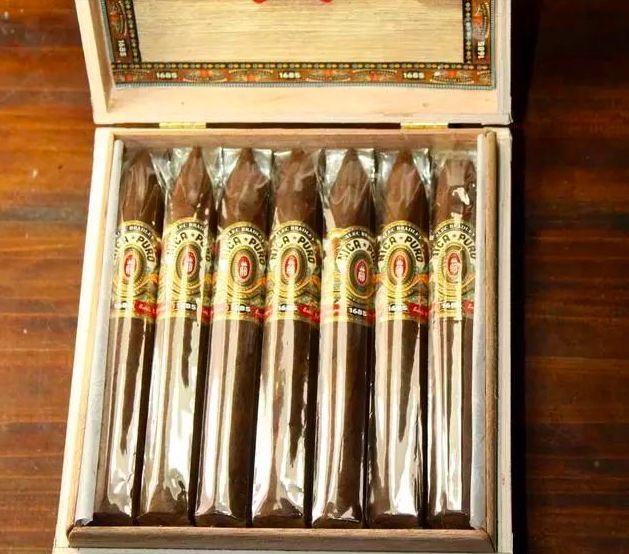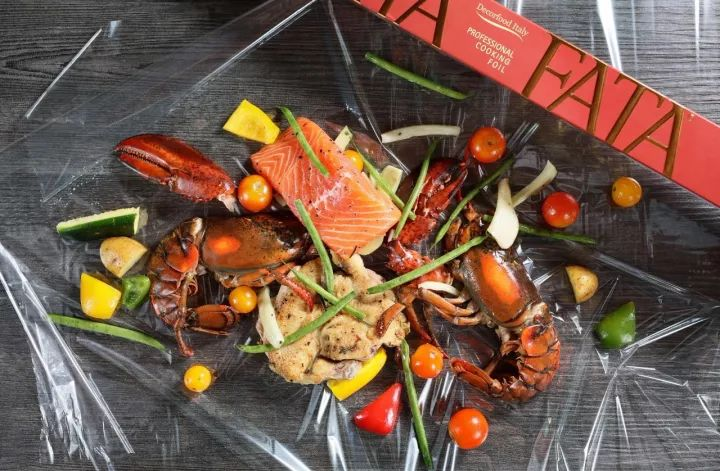Those who love to smoke cigars must be familiar with the early cellophane packaging. Except for Cuban cigars before 1992, which had no packaging paper, most cigars today are packaged in transparent packaging materials. But what exactly is cellophane and why is it so popular?
In 1910, Swiss chemist Jacques Brandenberger pioneered cellophane that met food safety standards and gained great reputation in the packaging industry of candy and tobacco products. The first cellophane cigar packaging was born in Tampa, Florida in 1927, and other countries quickly followed suit. In Cuba, until the 1990s, most cigar packaging materials there were made of cellophane. The decline of cellophane today is due to its relatively high production cost and the availability of synthetic materials made from mineral oil, but its quality maintenance is the first choice for cigar packaging.
High temperature resistant glazed paper has become a new generation of culinary artifacts, causing a whirlwind of “glazed paper” cooking in the European catering industry! The completely transparent glazed paper can directly see the changes in the cooking process of food, allowing the chef to adjust the time and temperature in a timely manner, retaining the nutrition and taste of the food, while also providing diners with a refreshing visual experience!
Boil glazed paper at high temperature! The chef uses Italian Carta Fata premium cooking paper that can withstand high temperatures of 230 ° C and can be cooked using various methods. Fresh ingredients such as lobster and crabs are wrapped in it to cook healthy food, while preserving the freshness and nutrition of the ingredients. This is an innovative cooking method that cannot be missed.
Cellophane, also known as cellophane film, is a thin film made by adhesive method using natural fibers such as cotton pulp and wood pulp as raw materials. It is transparent, non-toxic, and odorless.
The molecular chain has a wonderful micro permeability, which allows the product to breathe like an egg through the micropores on the eggshell, which is very beneficial for the preservation and activity of the product; Strong resistance to oily, alkaline, and organic solvents; Does not generate static electricity and does not self absorb dust; Made from natural fibers, it can absorb water in garbage and be decomposed without causing environmental pollution. Widely used as lining paper for goods and decorative packaging paper. Its transparency makes the interior of the product clear at a glance, and it also has properties such as moisture resistance, impermeability, breathability, and heat sealing, providing good protection for the product. Compared with ordinary plastic film, it has advantages such as no static electricity, dust prevention, and good twisting performance. Glass paper can be white, colored, etc. Can be used as a semi permeable membrane.
Cellophane is regenerated cellulose, and there is a wonderful breathability between its molecular groups, which is very beneficial for the preservation of goods. It is not fire-resistant but heat-resistant, and can withstand high temperatures of 190 ℃ without deformation. It can be used in food packaging for high-temperature disinfection together with food. In addition, as the raw material of cellophane comes from nature, it has strong decomposability
Also known as cellulite. A regenerated cellulose film with high transparency and luster. There are flat paper and web paper. Quantitative 30-60g/㎡. Colorless, can also be dyed into various colors. Paper is soft, transparent and smooth, without perforations, breathable, oil and water resistant. Moderate stiffness. It has good tensile strength, glossiness, and printability. The production method is different from papermaking and similar to the process of artificial silk. adopt α- Refined chemical wood pulp or cotton linter dissolved pulp with high cellulose content is used as raw materials to prepare alkaline cellulose through alkalization (18% sodium hydroxide), pressing, crushing, and other processes. After aging, carbon disulfide is added to yellowed cellulose xanthate, which is dissolved in sodium hydroxide solution to produce orange cellulose adhesive. The adhesive is matured at a temperature of 20-30 ℃, filtered to remove impurities and bubbles, and then extruded through a narrow gap in a film pulling machine. It flows into a coagulation bath of sulfuric acid and sodium sulfate mixture to form a thin film (regenerated cellulose film), which is then washed, desulfurized, bleached, desalinated, and plasticized (glycerol and ethylene glycol, etc.), and finally dried to produce. Used for packaging goods such as drugs, food, cigarettes, textiles, cosmetics, precision instruments, etc.
The change in tension of glass paper affects the elongation of the film during the printing process. Within the allowable range of strength, the elongation increases with the increase of tension, which makes it difficult to achieve the accuracy of color printing. The tension can be adjusted based on the type of substrate material and its elongation. For example, if the elongation of PE film is relatively large, the tension value should be smaller; For paper, PET, OPP, and other plastic films with low expansion rates, the tension can be appropriately increased. The surface is smooth and free of pores, and the ink layer is not easily fixed or not firmly fixed. After the first color printing is completed, it is easy to be stuck off by the ink from the next color overlay, causing incomplete patterns and text, resulting in defects;
After packaging items with it, it can prevent rust, moisture, and pollution. But cellophane also has drawbacks: high longitudinal strength, low transverse strength, poor tearing strength, and even a slight crack can easily break. Glass paper also has hydrophilicity, so it can absorb water. When it comes to water, it often adheres, and when it comes to heat, the paper pages are easily bonded into blocks. The characteristics of cellophane are high transparency, strong glossiness, and particularly bright color after printing images and texts, which cannot be achieved by plastic films; Good printing adaptability, without any treatment before printing, and glass paper also has anti-static treatment performance, which is not easy to adsorb dust and avoid printing faults such as image and text sticking. However, its moisture resistance is poor, and the film is prone to deformation due to temperature and humidity, resulting in difficult registration of images and text during printing.
The world’s only square chocolate has officially been born. Clara Ritter proposed to produce a type of chocolate that can be put into a sports jacket without reducing weight. This proposal quickly received recognition from the family. This type of chocolate is named “Rhett’s Sports Chocolate” because it fits well into men’s sportswear.
In 1939, the riots in Waldenburg.
During World War II, the production scale of chocolate gradually decreased and ultimately ceased production in 1940.
In 1946, they returned!
Alfred Ritter’s chocolate factory continues to produce various non cocoa candies.
In 1960, conquer the small squares of South Germany.
Alfred Otto Ritter has decided to focus the company’s business on chocolate cubes. Many other products such as holiday candy, long chocolate blocks, and hollow character chocolates are gradually discontinued. And successfully established the brand of Ritter Sport. At that time, the new square chocolate was wrapped in chocolate colored cellophane paper, with the Ritter Sport logo prominently marked on it.
In 1970, small diamonds were spread throughout Germany.
This year is an important one for this family business, as it has become well-known to the entire German public. Ritter Sport brings unprecedented yogurt flavored chocolate – the first chocolate in Germany to contain yogurt. At the same time, the television advertisements that spread throughout the country were also unprecedented in Germany at that time. This modern, enjoyable, and unique advertisement, along with the resounding slogan ‘Perfect chocolate is square’, emphasizes the uniqueness of Ritter Sport.
1) Cellophane
Cellophane is a highly transparent and glossy regenerated cellulose film, formerly known as cellophane, which is a transliteration of English cellophane. It is a type of paper used for packaging goods, which belongs to the category of packaging paper. Please note that there is also a term called celluloid, which is not paper, but a nitrocellulose plastic (the raw material for making table tennis balls). Celluloid is the English translation of celluloid. Don’t confuse the two.
The quantity of cellophane is generally 30-60g/m2. There are two types of paper: flat paper and web paper. Usually a colorless, transparent, and smooth thin sheet, without perforations, not breathable, not oil permeable, and not water permeable; Having a certain degree of stiffness; It has good tensile strength, glossiness, and printability. It can also be dyed into various colors (red, yellow, etc.).
Cellophane is regenerated cellulose, and the gaps between its molecular groups have a wonderful breathability, which is beneficial for the protection and preservation of goods. It is not fire-resistant, but heat-resistant and can withstand high temperatures of 190 ℃ without deformation. It can be used in food packaging for high-temperature disinfection together with food. Due to its natural origin, cellophane has strong decomposability and minimal impact on the environment.
Glass paper used α- Refined chemical wood pulp or cotton linter dissolved pulp with high cellulose content is used as raw materials, and alkali cellulose is prepared through alkalization (18% sodium hydroxide), pressing, crushing, and other processes. After aging, carbon disulfide is added to yellow it into cellulose xanthate, which is dissolved in sodium hydroxide solution to produce orange cellulose adhesive. The adhesive is matured at a temperature of 20-30 ℃, filtered to remove impurities and bubbles, and then extruded through a narrow gap in a film pulling machine. It flows into a coagulation bath of sulfuric acid and sodium sulfate mixture to form a thin film (regenerated cellulose film), which is then washed, desulfurized, bleached, desalinated, and plasticized (glycerol and ethylene glycol, etc.), and finally dried to produce.
2) Glass fiber paper
Glass fiber paper is an industrial paper commonly used as a filtering material, sound-absorbing material, insulation material, electrical insulation material, etc. It is a paper sheet made from small diameter glass fibers, with high flame retardancy, high resistance to chemical agents, and good dimensional stability.
This type of paper has some differences from ordinary paper making, as it uses 100% glass fiber (mainly composed of silica, with a diameter of 0.3-0.5) μ It is made by lightly beating, adding adhesive, or adding some chemical wood pulp on a long web paper machine or circular web paper machine. You can also add some silicone or colloidal alumina to improve the strength of the paper.
The production process of glass fiber paper (or glass fiber air filter paper) is relatively simple compared to the general papermaking process. Because fiberglass does not require beating, it only needs to be dispersed. And there is no need to press when making copies. Reduced processes and saved energy.
The process flow is as follows: fiberglass → dispersion → slurry storage tank → slurry pump → pre mixing tank → mixing box → grit tray → slurry flushing tank → slurry pump → stabilizing box → flow box → mesh part → drying room → coiling → slitting and packaging
Cellophane fim is EN13432 industry compostable and OK home compostable , feel free to discuss via williamchan@yitolibrary.com
Cellophane Film – HuiZhou YITO Packaging Co., Ltd.
Post time: Sep-22-2023


